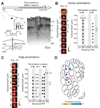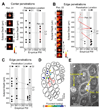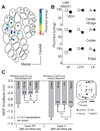Endocannabinoid signaling is required for development and critical period plasticity of the whisker map in somatosensory cortex
- PMID: 19945395
- PMCID: PMC2796273
- DOI: 10.1016/j.neuron.2009.10.005
Endocannabinoid signaling is required for development and critical period plasticity of the whisker map in somatosensory cortex
Abstract
Type 1 cannabinoid (CB1) receptors mediate widespread synaptic plasticity, but how this contributes to systems-level plasticity and development in vivo is unclear. We tested whether CB1 signaling is required for development and plasticity of the whisker map in rat somatosensory cortex. Treatment with the CB1 antagonist AM251 during an early critical period for layer (L) 2/3 development (beginning postnatal day [P] 12-16) disrupted whisker map development, leading to inappropriate whisker tuning in L2/3 column edges and a blurred map. Early AM251 treatment also prevented experience-dependent plasticity in L2/3, including deprivation-induced synapse weakening and weakening of deprived whisker responses. CB1 blockade after P25 did not disrupt map development or plasticity. AM251 had no acute effect on sensory-evoked spiking and only modestly affected field potentials, suggesting that plasticity effects were not secondary to gross activity changes. These findings implicate CB1-dependent plasticity in systems-level development and early postnatal plasticity of the whisker map.
Figures








References
-
- Allen CB, Celikel T, Feldman DE. Long-term depression induced by sensory deprivation during cortical map plasticity in vivo. Nat Neurosci. 2003;6:291–299. - PubMed
-
- Alloway KD. Information Processing Streams in Rodent Barrel Cortex: The Differential Functions of Barrel and Septal Circuits. Cereb. Cortex. 2008;18:979–989. - PubMed
-
- Armstrong-James M, Fox K. Spatiotemporal convergence and divergence in the rat S1 "barrel" cortex. J. Comp. Neurol. 1987;263:265–281. - PubMed
Publication types
MeSH terms
Substances
Grants and funding
LinkOut - more resources
Full Text Sources
Molecular Biology Databases

